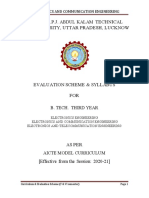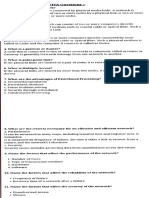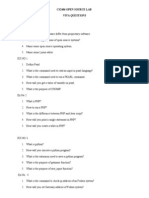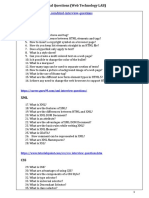ADE Lab Viva Question and Answer 2018
Uploaded by
NITHIN NADE Lab Viva Question and Answer 2018
Uploaded by
NITHIN N1) What are Universal Gates?
Universal gates can implement any logic circuit, including the basic gates.
2) What is Logic Gates?
Logic gates are the basic building blocks of any digital system. It is an electronic circuit
having one or more than one input and only one output. The relationship between the
input and the output is based on a certain logic.
3) What is combinatorial circuit?
Combinational Logic Circuits are memory less digital logic circuits whose output at any
instant in time depends only on the combination of its inputs.
4) What is adder?
An adder is a digital logic circuit in electronics that implements addition of numbers.
5) What is the application of gray code?
The reflected binary code was originally designed to prevent spurious output from
electromechanical switches. Today, Gray codes are widely used to facilitate error
correction in digital communications such as digital terrestrial television and some cable
TV systems.
6) What is code conversion?
Conversion of signals, or groups of signals, in one code into corresponding signals, or
groups of signals, in another code
Or
A process for converting a code of some predetermined bit structure, such as 5, 7, or 14
bits per character interval, to another code with the same or a different number of bits
per character interval
7) What is the number of multiplexer required to build a 8:1 multiplexer using 2:1
multiplexer?
7- 2:1 multiplexers are required.
8) What is Code?
The group of symbols is called as code.
9) What is edge triggering?
Triggering* means making a circuit active. In level triggering the circuit will become
active when the gating or clock pulse is on a particular level.
10) What is the race around condition in JK flip flops?
In flip flops when clock pulse is applied, output changes when input changes. But in JK
flip flop, when J=1,K=1 , at each clock pulse output changes(output toggles) without any
change in the input. This is called RACE AROUND CONDITION.
11) What is counter?
Counter is a sequential circuit. A digital circuit which is used for counting pulses is
known counter. Counter is the widest application of flip-flops. It is a group of flip-flops
with a clock signal applied.
12) What is register?
Registers are groups of flip-flops , where each flip-flop is capable of storing one bit of
information. An n-bit register is a group of n flip-flops. The basic function of a register is
to hold information in a digital system and make it available to the logic elements for the
computing process.
13) Which register is faster?
PIPO is faster.
14) What is ring counter?
A ring counter is a type of counter composed of flip-flops connected into a shift register,
with the output of the last flip-flop fed to the input of the first, making a "circular" or
"ring" structure.
15) What is switch tail counter?
A twisted ring counter, also called switch-tail ring counter, walking ring counter,Johnson
counter, or Möbius counter, connects the complement of the output of the last shift
register to the input of the first register and circulates a stream of ones followed by zeros
around the ring.
16) What is synchronous counter?
If the "clock" pulses are applied to all the flip-flops in a counter simultaneously, then
such a counter is called as synchronous counter.
17) What is asynchronous counter?
Ripple counter is an asynchronous counter where only the first flip-flop is clocked by an
external clock. All subsequent flip-flops are clocked by the output of the preceding flip-
flop. Asynchronous counters are also called ripple-counters because of the way the clock
pulse ripples it way through the flip-flops.
18) Define parity generator, checker.
A parity check is the process that ensures accurate data transmission between nodes
during communication. A parity bit is appended to the original data bits to create an
even or odd bit number; the number of bits with value one.
A Parity Generator is a Combinational Logic Circuit that Generates the Parity bit in the
Transmitter.
19) Why multiplexer is called universal circuit?
Any Boolean function can be implemented using multiplexer.
20) What is multiplexer?
A multiplexer is a device that performs multiplexing; it selects one of many analog or
digital input signals and forwards the selected input into a single line. A multiplexer of
2n inputs has n select lines, which are used to select which input line to send to the
output.
21) What is PAL?
Programmable Array Logic (PAL) is a commonly used programmable logic device
(PLD). It has programmable AND array and fixed OR array.
22) What is PLA?
Programmable Logic Array(PLA) is a fixed architecture logic device with programmable
AND gates followed by programmable OR gates.
23) What is Flip Flop?
A flip flop is an electronic circuit with two stable states that can be used to store binary
data., flip-flop is a gating or clocking mechanism.
24) State the drawback of Kmap?
K-map method is convenient method for minimizing Boolean functions up to 5
variables. But, it is difficult to simplify the Boolean functions having more than 5
variables by using this method.
25) Differentiate between Combinational circuits and Sequential circuits
Combinational circuits are defined as the time independent circuits which do not
depends upon previous inputs to generate any output are termed as combinational
circuits. Sequential circuits are those which are dependent on clock cycles and depends
on present as well as past inputs to generate any output.
26) What is a latch?
Latches are basic storage elements that operate with signal levels (rather than signal
transitions).
27) What is Demultiplexer ?
A demultiplexer is a device taking a single input signal and selecting one of many data-
output-lines, which is connected to the single input. A multiplexer is often used with a
complementary demultiplexer on the receiving end.
28) Give one real world example for Multiplexer and Demultiplexer
A real world example is the creation of telemetry for transmission from the
computer/instrumentation system of a satellite, space craft or other remote vehicle to a
ground-based system.
29) What is an Encoder ?
An encoder is a device, circuit, transducer, software program, algorithm or person that
converts information from one format or code to another, for the purposes of
standardization, speed, secrecy, security, or saving space by shrinking size.
30) What is a Decoder ?
A decoder is a device which does the reverse of an encoder, undoing the encoding so
that the original information can be retrieved. The same method used to encode is
usually just reversed in order to decode.
31) What is an Integrated Circuit ?
An integrated circuit (also known as IC, chip, or microchip) is a miniaturized electronic
circuit (consisting mainly of semiconductor devices, as well as passive components) that
has been manufactured in the surface of a thin substrate of semiconductor material.
Integrated circuits are used in almost all electronic equipment in use today and have
revolutionized the world of electronics. Computers, cellular phones, and other digital
appliances are now inextricable parts of the structure of modern societies, made possible
by the low cost of production of integrated circuits.
32) What is Flip-flop ? What are the different types of Flip-flop ?
A flip-flop is an electronic circuit (a bistable multivibrator) that has two stable states and
thereby is capable of serving as one bit of memory. A flip-flop is usually controlled by
one or two control signals and/or a gate or clock signal. The output often includes the
complement as well as the normal output.
33) Explain the difference between the sequential and combinational circuit ?
Digital electronics is classified into combinational logic and sequential logic.
Combinational logic output depends on the inputs levels, whereas sequential logic
output depends on stored levels and also the input levels.
34) What is a D flip-flop?
The D flip-flop is the most common flip-flop in use today. It is better known as delay
flip-flop (as its output Q looks like a delay of input D) or data latch.
35) What is decade counter?
A decade counter is a binary counter that is designed to count to 1010 (decimal 10).
36) What is duty cycle?
Duty cycle is the proportion of time during which a component, device, or system is
operated. The duty cycle can be expressed as a ratio or as a percentage.
37) List the different DAC techniques.
Binary ladder, resistive divider network, DAC 808 IC
38) List the different ADC techniques.
Simultaneous A/D conversion, Counter method, Single RAMP, Dual Ramp
39) Number of stable states present in
Astable multivibaratior : No stable state
Monostable multivibaratior: One stable state
40) What is OPAMP?
An operational amplifier is a DC-coupled high-gain electronic voltage amplifier with a
differential input and, usually, a single-ended output.
41) What is relaxation oscillator
In electronics a relaxation oscillator is a nonlinear electronic oscillator circuit that
produces a nonsinusoidal repetitive output signal, such as a triangle wave or square
wave.
42) List the application of OPAMP?
Comparator, Current to Voltage converter, Relaxation oscillator, Voltage to current
converter
43) What is HDL?
In computer engineering, a hardware description language (HDL) is a specialized
computer language used to describe the structure and behavior of electronic circuits, and
most commonly, digital logic circuits.
44) List different HDL Languages?
VHDL, Verilog, System C
45) List the different models used in Verilog?
Structural, Behavioral, Data flow model.
46) What is negative logic?
In negative logic 0V means HIGH and 5V means LOW
47) What does signal generator do?
A signal generator is an electronic device that generates repeating or non-repeating
electronic signals in either the analog or the digital domain. It is generally used in
designing, testing, troubleshooting, and repairing electronic or electroacoustic devices,
though it often has artistic uses as well.
48) What is forbidden condition?
A forbidden state in this case means that the output is non deterministic, i.e. unknown.
49) What is Entered variable Map?
A variable entered map (VEM) is a Karnaugh map in which the size of the map is
reduced by removing one or more of the variables from the specification of the map cell
locations. Instead of having only the 1's and 0's in the cells of the original map, the cells
of the VEM contain functions of the variables which were removed.
50) What is magnitude comparator?
A digital comparator or magnitude comparator is a hardware electronic device that takes
two numbers as input in binary form and determines whether one number is greater
than, less than or equal to the other number.
You might also like
- Samsung Digital Video Camcorder SC-MX20 Series (Chassis MX20) Parts and Service ManualNo ratings yetSamsung Digital Video Camcorder SC-MX20 Series (Chassis MX20) Parts and Service Manual98 pages
- EST200 (DEC2020) - Solutions - Ktunotes - in 2No ratings yetEST200 (DEC2020) - Solutions - Ktunotes - in 241 pages
- VTU Exam Question Paper With Solution of 18CS34 Computer Organization Dec-2019-Gopika DNo ratings yetVTU Exam Question Paper With Solution of 18CS34 Computer Organization Dec-2019-Gopika D19 pages
- Addition and Subtraction With Signed 2s ComplementNo ratings yetAddition and Subtraction With Signed 2s Complement3 pages
- 8259 PIC Microprocessor and Block DiagramNo ratings yet8259 PIC Microprocessor and Block Diagram4 pages
- Bms Institute of Technology Department of Mca Sub Code - 16mca38 Algorithms Laboratory Viva QuestionsNo ratings yetBms Institute of Technology Department of Mca Sub Code - 16mca38 Algorithms Laboratory Viva Questions13 pages
- CSL331 System Software and Microprocessor LabNo ratings yetCSL331 System Software and Microprocessor Lab144 pages
- Logic Design Viva Question Bank: Compiled byNo ratings yetLogic Design Viva Question Bank: Compiled by23 pages
- KTU S5 Microprocessor and Microcontroller CSE May 2019 Question Paper0% (1)KTU S5 Microprocessor and Microcontroller CSE May 2019 Question Paper2 pages
- Detection of Radar Signals in Noise: Unit - 5No ratings yetDetection of Radar Signals in Noise: Unit - 560 pages
- Program For Searching A Number or Character in String For 8086No ratings yetProgram For Searching A Number or Character in String For 808623 pages
- UGC NET Electronic Science Paper II Jun 05No ratings yetUGC NET Electronic Science Paper II Jun 0512 pages
- Register Transfer Language Register Transfer Bus and Memory Transfers Logic Micro-Operations Shift Micro-Operations Arithmetic Logic Shift UnitNo ratings yetRegister Transfer Language Register Transfer Bus and Memory Transfers Logic Micro-Operations Shift Micro-Operations Arithmetic Logic Shift Unit11 pages
- (SS) System Software Viva Question and AnswersNo ratings yet(SS) System Software Viva Question and Answers15 pages
- ADE Lab Viva Question and Answer 2018 PDFNo ratings yetADE Lab Viva Question and Answer 2018 PDF6 pages
- 4.2.2.6 Common Problems and Solutions For Displays100% (1)4.2.2.6 Common Problems and Solutions For Displays3 pages
- Implementation of Smart Child Rescue Robot From Borewell Using Arm Mechanism100% (1)Implementation of Smart Child Rescue Robot From Borewell Using Arm Mechanism37 pages
- Sound Devices Xl-Smartbattery Battery Lithium-Ion, 14.4vNo ratings yetSound Devices Xl-Smartbattery Battery Lithium-Ion, 14.4v7 pages
- Microsoft Office, Keyboard & Mouse by Bizgram Whatsapp 87776955 PDFNo ratings yetMicrosoft Office, Keyboard & Mouse by Bizgram Whatsapp 87776955 PDF1 page
- Spectro Xsort: Handheld XRF SpectrometersNo ratings yetSpectro Xsort: Handheld XRF Spectrometers4 pages
- Catalogue: Corporate Printers & StationersNo ratings yetCatalogue: Corporate Printers & Stationers72 pages
- Samsung Digital Video Camcorder SC-MX20 Series (Chassis MX20) Parts and Service ManualSamsung Digital Video Camcorder SC-MX20 Series (Chassis MX20) Parts and Service Manual
- VTU Exam Question Paper With Solution of 18CS34 Computer Organization Dec-2019-Gopika DVTU Exam Question Paper With Solution of 18CS34 Computer Organization Dec-2019-Gopika D
- Addition and Subtraction With Signed 2s ComplementAddition and Subtraction With Signed 2s Complement
- Bms Institute of Technology Department of Mca Sub Code - 16mca38 Algorithms Laboratory Viva QuestionsBms Institute of Technology Department of Mca Sub Code - 16mca38 Algorithms Laboratory Viva Questions
- KTU S5 Microprocessor and Microcontroller CSE May 2019 Question PaperKTU S5 Microprocessor and Microcontroller CSE May 2019 Question Paper
- Program For Searching A Number or Character in String For 8086Program For Searching A Number or Character in String For 8086
- Register Transfer Language Register Transfer Bus and Memory Transfers Logic Micro-Operations Shift Micro-Operations Arithmetic Logic Shift UnitRegister Transfer Language Register Transfer Bus and Memory Transfers Logic Micro-Operations Shift Micro-Operations Arithmetic Logic Shift Unit
- 4.2.2.6 Common Problems and Solutions For Displays4.2.2.6 Common Problems and Solutions For Displays
- Implementation of Smart Child Rescue Robot From Borewell Using Arm MechanismImplementation of Smart Child Rescue Robot From Borewell Using Arm Mechanism
- Sound Devices Xl-Smartbattery Battery Lithium-Ion, 14.4vSound Devices Xl-Smartbattery Battery Lithium-Ion, 14.4v
- Microsoft Office, Keyboard & Mouse by Bizgram Whatsapp 87776955 PDFMicrosoft Office, Keyboard & Mouse by Bizgram Whatsapp 87776955 PDF
























































































